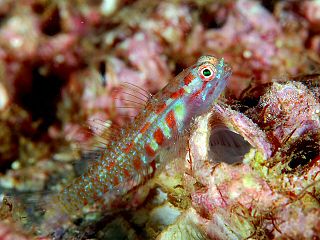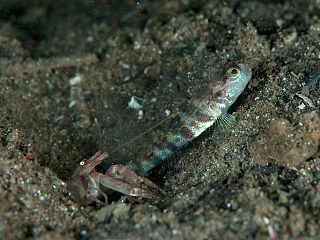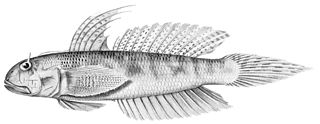
Eviota is a genus of fish in the family Gobiidae, commonly as dwarfgobies found in the Indo-Pacific region, where it is distributed from Japan to Australia and from Africa to Pitcairn Island. Species are mainly associated with coral reefs. Many of these fish are short-lived, with life cycles as brief as 3.5 weeks in the tropics. Some species are hermaphrodites and some representatives live symbiotically among the tentacles of the mushroom coral.

Amblyeleotris is a genus of fish in the family Gobiidae found throughout the Indo-Pacific region. This is the largest genus of the shrimp gobies or prawn gobies, so-called because of their symbiotic relationship with certain alpheid shrimps. The shrimp excavates and maintains a burrow used by both animals while the goby, which has far superior eyesight, acts as a lookout for predators. The shrimp maintains almost constant contact with the fish with an antenna. Fossil Amblyeleotris otoliths have been found together with alpheid shrimp remnants from as early as late early Miocene (Burdigalian) suggesting a possible mutualistic association since then.

Mugilogobius is a genus of fish in the family Gobiidae. They are found in fresh, brackish and marine water of the Indo-Pacific region. Several of the freshwater species have highly restricted distributions.

Tomiyamichthys is a genus of gobies found from the Red Sea through the Indian Ocean to the western Pacific Ocean.

Amblygobius is a genus of fish in the family Gobiidae found in the Indian and Pacific Ocean.

The Gobionellinae are a subfamily of fish which was formerly classified in the family Gobiidae, the gobies, but the 5th Edition of Fishes of the World classifies the subfamily as part of the family Oxudercidae. Members of Gobionellinae mostly inhabit estuarine and freshwater habitats; the main exception is the genus Gnatholepis, which live with corals in marine environments. The subfamily is distributed in tropical and temperate regions around the world with the exception of the northeastern Atlantic Ocean, the Mediterranean Sea, and the Ponto-Caspian region. It includes around 370 species and 55 genera: Wikipedia articles about genera list about 389 species.

Cryptocentrus, also known as Watchman gobies, and one of the genera known as shrimp gobies or prawn gobies, is a genus of gobies native to tropical marine waters of the Indian and Pacific oceans.

Callogobius is a genus of fish in the family Gobiidae found in brackish and marine waters of the Indian and Pacific Ocean.
Eugnathogobius is a genus of gobies native to fresh, brackish and marine waters of the Indian Ocean and the western Pacific Ocean region.

Myersina is a genus of ray-finned fish from the family Gobiidae, the true gobies which are found from the Atlantic coast of South Africa through the Indian Ocean to the western Pacific Ocean. The generic name honours the American ichthyologist George S. Myers (1905-1985) who was a younger colleague of Herre's at the time at which he described the genus and who went on to be president of the American Society of Ichthyologists and Herpetologists, the head of the Division of Fishes at the United States National Museum and an ichthyologist for the United States Fish and Wildlife Service.

Oxyurichthys is a genus of fish in the subfamily Gobionellinae, commonly known as arrowfin gobies. They are distributed in the tropical and subtropical Indian and Pacific Oceans; one species is also known from the western Atlantic Ocean. Most species live in shallow waters under 10 meters deep over fine substrates such as silt.

Psammogobius is a genus of fish in the family Gobiidae found in the Atlantic, Indian and Pacific Ocean.
Ernest Albert Lachner was an American ichthyologist with an international reputation for his research on Indo-Pacific gobies and cardinalfishes.
Loren Paul Woods (1913–1979) was an American ichthyologist and museum curator at the Field Museum of Natural History In Chicago. He joined the museum's education department as a guide lecturer in 1938. In 1941, he was transferred to the Division of Fishes, from where he retired in 1978. His career was interrupted by a four-year period of duty with the United States Navy during World War II. While he was in the navy, Marion Griswold Grey served as the unpaid curator, becoming an associate at the museum when Woods resumed his post. During his time at the Field Museum, he assembled specimen collections of North American freshwater fish and Atlantic, Indian, and Pacific Ocean marine fish. This material resulted in a major expansion of the museum's fishes holdings, which had previously been a mostly freshwater collection. Woods is best remembered for his publications on damselfish, squirrelfish, and Berycidae.
Sueviota lachneri, also known as Lachner's dwarfgoby, is a species of fish in the family Gobiidae. found in the Maldives.
Gobiopsis woodsi, also known as Woods' barbelgoby, is a species of goby found in the Indo-west Pacific.
Gobiopsis exigua is a species of goby found in the western-central Pacific Ocean.
Gobiopsis angustifrons, the narrownape barbelgoby, is a species of goby found in the western-central Pacific Ocean from Indonesia, to Australia, and the Solomon Islands.
Gobiopsis bravoi, or Bravo's bearded goby, is a species of goby found in the western Pacific Ocean from the Philippines, Irian Jaya, and possibly Okinawa, Ryukyu Islands and Palau.
Gobiopsis uranophilus is a species of goby, which is a type of fish.











